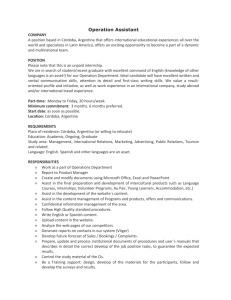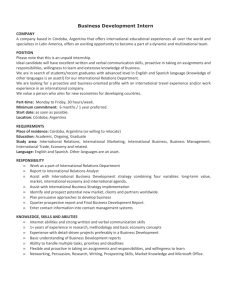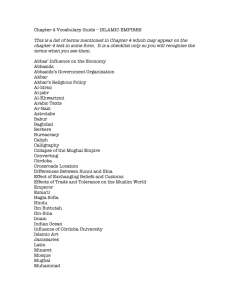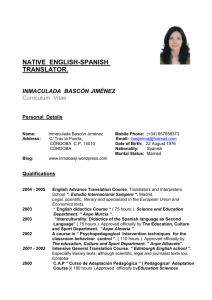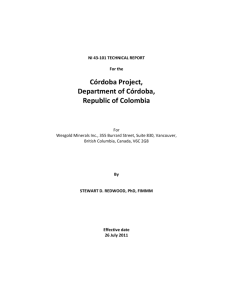The Córdoba Museum
advertisement
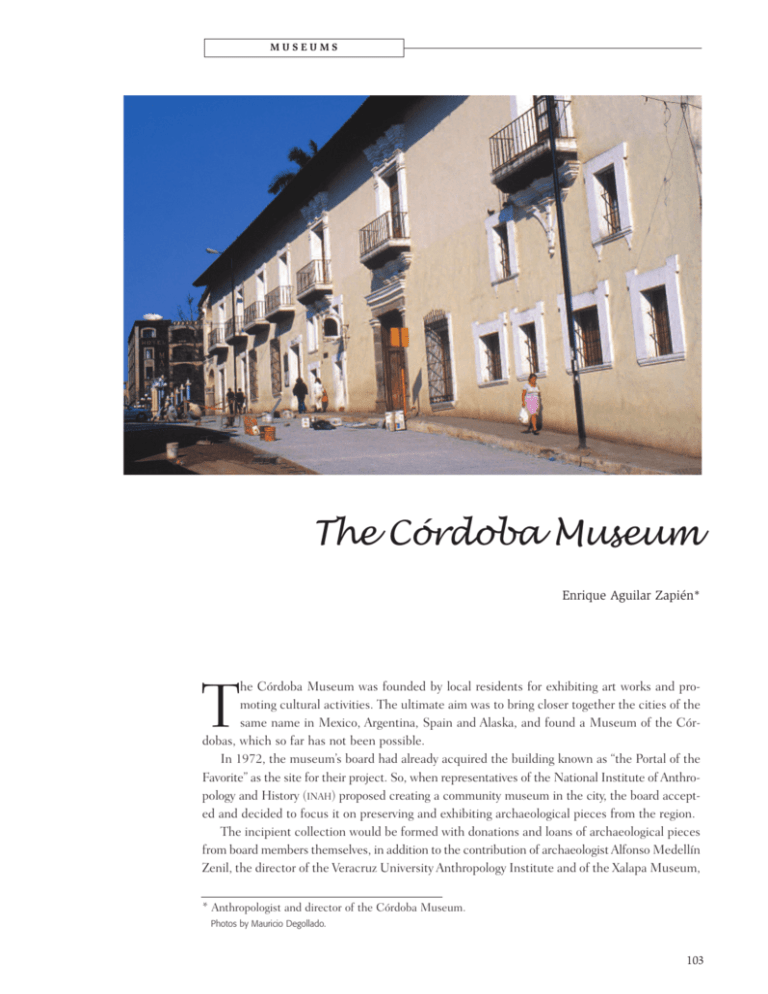
MUSEUMS The Córdoba Museum Enrique Aguilar Zapién* he Córdoba Museum was founded by local residents for exhibiting art works and promoting cultural activities. The ultimate aim was to bring closer together the cities of the same name in Mexico, Argentina, Spain and Alaska, and found a Museum of the Córdobas, which so far has not been possible. In 1972, the museum’s board had already acquired the building known as “the Portal of the Favorite” as the site for their project. So, when representatives of the National Institute of Anthropology and History (INAH) proposed creating a community museum in the city, the board accepted and decided to focus it on preserving and exhibiting archaeological pieces from the region. The incipient collection would be formed with donations and loans of archaeological pieces from board members themselves, in addition to the contribution of archaeologist Alfonso Medellín Zenil, the director of the Veracruz University Anthropology Institute and of the Xalapa Museum, T * Anthropologist and director of the Córdoba Museum. Photos by Mauricio Degollado. 103 VOICES OF M EXICO • 75 The archaeological rooms exhibit pieces from six different Mesoamerican cultures. The archaeological rooms show objects from the Olmec, Huaxtec and Totonac cultures, which make up most of the museum’s collection. 104 who donated part of the objects found in his excavations in the central semi-arid area of Dicha Tuerta, Nopiloa and Remojadas. These pieces date from the pre-classical period (1200 to 200 B.C.) and the classical period (A.D. 200 to 900). The small initial selection of 46 pieces has grown in size and quality since then: today we have 3,200 pieces representing the Olmec, Huaxtec, Totonac or Remojadas, Teotihuacan, Mayan and Mixtec cultures. In addition, there are many locally-made clay and stone receptacles and figurines, among which are the outstanding sculptures from the Palmillas archaeological dig, recognizable by their facial deformations. A strong earthquake in the CórdobaOrizaba region August 28, 1973 cracked the building, originally restored by architect Flores Marini. Despite the damage, the museum continued to promote the city’s cultural development by organizing concerts, exhibits, plays, workshops and the traditional Day of the Dead offerings. Once the building had been restored again and the museography improved, in 1984 the museum put on the exhibit of central Veracruz archaeological pieces, arranged in chronological order beginning in the pre-classical period, followed by the classical, post-classical and historical periods. The exhibit gives preference to objects from the central, semi-arid region where the city of Córdoba is located. MUSEUM ORGANIZATION The museum is divided into six rooms: four for archaeology, a room for history and another for temporary exhibits. The archaeological rooms show objects from the Olmec, Huaxtec and Totonac (or Remojadas) cultures chronologically, which make up most of the museum’s collection on display. Of special interest is the impressive reproduction of Mictlantecuhtli, god of death, depicted seated on his throne in the ninth underworld, or the place of nothing. The original, made of unfired clay, is displayed at the Zapotal archaeological site in the municipality of Ignacio de la Llave. Tradition has it that Mictlantecuhtli rules over the underworld and the forms MUSEUMS of death, two important aspects of any Mesoamerican culture. Women who died during childbirth and warriors fallen in battle or killed on the stone of sacrifice had the privilege of accompanying the sun on his daily journey. Those who died of common diseases or from old age went to Mictlán, a place where “souls disappear and die.” Each October 31, November 1 and 2, the Córdoba Museum celebrates the Day of the Dead by building an altar of offerings to Mictlantecuhtli. Of the “ax, yokes, palms and padlocks” complex displayed in the rooms, one important example is a palm made of basalt from the early classical period, on the front of which is carved a monkey and on the back of which is a serpent, the animal associated with the night. On the stairway up to the History Room is a relief depicting two of the most important events in local history: the city’s May 21, 1821 battle between the royal Spanish army and the insurgent army fighting at the end of the War of Independence. That same year, on August 24, the last viceroy of New Spain and Agustín de Iturbide, the head of the insurgent or Trigarante army, signed the Treaties of Córdoba that stipulated the separation of New Spain from the mother country. The last room is used for temporary exhibitions of painting, sculpture and photography. ARCHAEOLOGY IN THE VALLEY OF CÓRDOBA The Valley of Córdoba is located in the Southern Sierra Madre, part of the eastern mountain ranges crowned by Orizaba Peak, crisscrossed by fertile valleys like Maltrata, Orizaba, Córdoba and Amatlán de los Reyes. Archaeological evidence found in this region leads us to believe that groups of Olmecs occupied it from 1500 B.C. and founded small settlements where they mingled with local cultures. Their main economic activity was working the obsidian mined at Orizaba Peak. This group of settlements became a stopping-off-place for the caravans that united the regions of Mesoamerica, the Cen- The History Room. Relief depicting the signing of the treaty that made Mexico independent. Arranged in chronological order, the exhibit gives preference to objects from the central, semi-arid region where the city of Córdoba is located. Mayan vase, recently donated to the museum. 105 VOICES OF M EXICO • 75 The museum boasts a very interesting piece shaped like a dog-bat-jaguar, with a bowl on its haunch. Dog-bat-jaguar. Palm made of basalt from the early classical period. 106 tral Highland with the Southeast and the Olmec area with the Mayan. From time immemorial, the pass from the Central Highland to the coastal plains of the Gulf of Mexico and the Southeast where the Olmec and Mayan cultures flourished had been the caravans’ natural route. Centuries later, this same phenomenon gave rise to the foundation of Villa de Córdoba in 1618. It would become a bastion that protected the caravans that went from the Highlands to the coast and then to Spain. In 1200 B.C. during the pre-classical period, groups of Olmecs began to exploit the obsidian mines at Orizaba Peak, and so they opened up trade routes toward the south of Puebla, the valley of Morelos and the Central Highland. This is confirmed by archaeological finds in the region: Olmec-type figurines, known as “baby faces,” among other items. By the middle classical period, the trade and regional intercommunication routes were dominated by Teotihuacan. To strengthen their domination, the Teo- tihuacans established control posts like Matacapan, where objects typical of that culture have been found: the talud-panel, orange ceramics and candelabra. In this same period, important religious centers were established like El Tajín, Xochicalco and Cacaxtla, which took over trade after the fall of Teotihuacan in A.D. 650. In the Córdoba region, 66 sites from this period have been found: four very large ones, measuring over 100 hectares, like the Toro Prieto Hill; other, medium-sized and small ones boast structures like the bases of pyramids, plazas and ball game courts. There are, in addition, natural sites like caves, springs and underground rivers used for worship, and art work associated to these sites. When the Spanish arrived, the region of Córdoba belonged to the land of Cuauhtochco, which stretched from the slopes of Orizaba Peak to the plains of the Gulf of Mexico, including the Valley of Córdoba, Amatlán. THE DEITIES FROM THE DARK WORLD Other important discoveries in the Córdoba region are the figurines presumably associated with the worship of the deities of the dark world or the depths of the Earth. The museum boasts a very interesting piece shaped like a dog-bat-jaguar (see figure), with a bowl on its haunch. It may have been used to hold grain or perhaps water. Some chroniclers like Bernardino de Sahagún thought that figures of this sort are related to the Mexica conception of the mountains as receptacles for water that are reached through caves in the dry season. Another example of the importance of the places where rivers spring from the earth for deciding where to settle is found in Atoyac, where an underground MUSEUMS river formed by the Orizaba Peak’s melting ice comes out of the ground in hues of turquoise blue. In 1980, archaeologist Ramón Arellanos Melgarejo found pieces of large ceramic recipients, plates, pots and boxes, a flute and some fragments of figurines at the bottom of a well. Of this find, the museum displays two purposely broken yokes. Both represent the toad or monster of the earth from which a figure is emerging. The fact that they are fragmented indicates that before being thrown in, small holes were made in them so that when they sank, the water that entered through them would represent Tlaloc’s tears. The same procedure was followed with the recipients. Recently, that same well has yielded smiling little faces and figurines representing Tlaloc. Worshipping in caves did not disappear with the Spanish conquest of 1521. Some caves are still used to hold the Xochitlalli, a ceremony in which the officiant digs a hole to communicate with the inside of the Earth and ask its forgiveness for having stripped it of its leaves and having burned it and to beg for a better crop this year. Totomochapa Cave, in the Zongolica Mountains is one such place, where objects that make up an offering have been found. In the late post-classical period, groups of Nahuas migrated to central Veracruz. We can infer that from the ninth century on, many groups of Nahuas migrated to the region, changing the traditional pattern of settlements. The last migration was of the Mexicas, which had a great impact on local groups’ cultural development. One product of this contact-domination between the fiefdom of Cuauhtochco and the Mexica empire is a circular basalt sculpture, perforated in the center and with reliefs on the four points of the compass, found in the city of Córdoba. The sculpture has two possible uses: one as an anchor for sacrifice of warriors and the other as a marker for the mobile ball game. MUSEO DE CÓRDOBA CALLE 3, BETWEEN AVENIDA 3 AND AVENIDA 5, CENTRO, CÓRDOBA, VERACRUZ TELEPHONE: (271) 405 2326 VISITING HOURS: MONDAY TO SUNDAY, 9 A.M. TO 2 P.M. AND 4 P.M. TO 8 P.M. GUIDED TOURS FROM 4 P.M. TO 8 P.M. FREE ADMISSION 107
